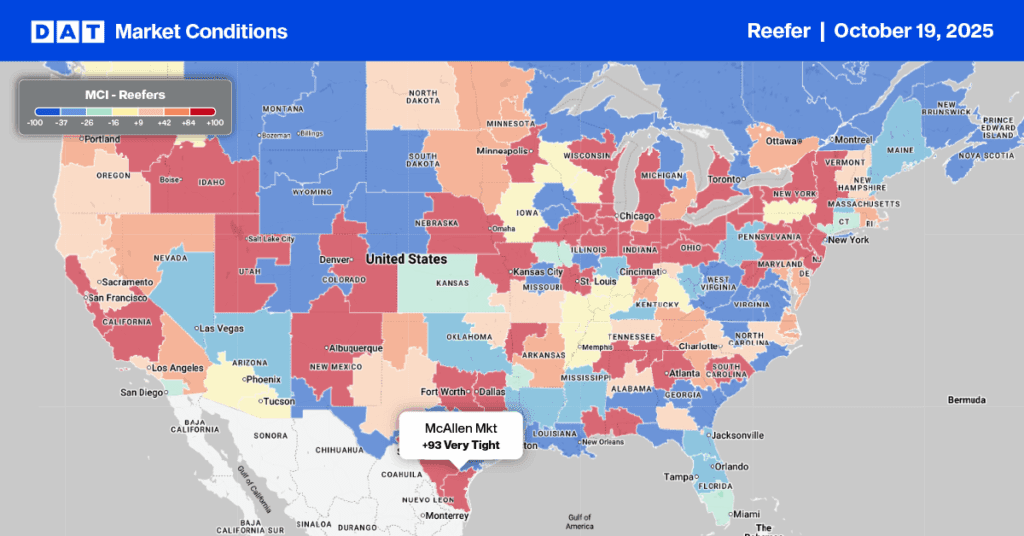Even the most experienced drivers struggle with icy roads and sub-zero temperatures as winter delivers a mix of nasty weather and road conditions. For drivers, the miles get more complex and slower compared to summer, and any hidden equipment fault is exposed almost immediately, making now the time to prepare for winter.
DAT Freight & Analytics asked several experienced long-haul drivers for their best tips for winter driving, including Rocky Mountains veteran driver Dave Nadeau. According to Dave, who hauls propane gas from Canada to the U.S. Northwest, he’s always watching the ambient temperature, “18 degrees Fahrenheit seems to be the magic number — any warmer than that and the road surface is slippery or any colder the road surface seems to be sticky and dry”.
On the technical side, Dave advises drivers to slow down because even though drivers feel they can accelerate and corner with more confidence, if they have to brake hard, they’ll slide just like a bobsled in winter. Other hot tips for winter driving include being smooth, braking gently, and ahead of time, so drivers avoid their wheels locking up — even anti-lock brakes slide on slick surfaces. Dave’s final tip is tire color and appearance. “If they look shiny and wet with water spraying from them, and the highway crews haven’t sprayed de-icer, you might be driving into a black ice situation. If the tires look dry (no water spray), then the road surface will be cold and sticky”, he said.
So, where does a driver start preparing for trucking in winter?
Yourself
The first place is the driver so let’s start with survival in freezing temperatures. If your engine fails, the most important thing to do is ensure you are protected from the cold:
- Ensure your first-aid kit is fully stocked.
- Carry plenty of warm clothes and layer up! Layering is an effective way to protect yourself from the cold, and you can add or remove it, depending on the conditions.
- Insulated gloves and boots. Beanies are essential
- Even a snowsuit in the event you break down for an extended period
- Make sure you have plenty of food and water – you never know how long help will take to reach you.
- Carry extra blankets and a cold-weather sleeping bag
- Clip-on ice studs for your work boots are also great, as they help prevent slipping in icy conditions.
- Winter means more time driving and inspecting your equipment after dark. Keep your headlamp, cell phone charged, safety vest within reach, and road triangles and flares handy.
Your Truck
As far as equipment is concerned, DAT drivers recommend that you:
- Carry a strong tow strap in the event you get stuck.
- Add winter wiper fluid that can handle freezing temperatures.
- Treat your windshield with a water-repellant formula.
- Carry a few extra sets of wiper blades
- Add anti-gel additives to your fuel if your diesel supplier hasn’t already treated your fuel.
- This is particularly relevant to those truckers who fuel in the south and then head north with a load.
- Carry extra emergency de-ice products to reliquify gelled fuel and de-ice frozen fuel filters
- Carry extra fuel filters if they ice up – you can never have enough.
- A container with make-up fuel to fill fuel filters when you change them
- Carry an aerosol can of de-icing fluid
- Buy a powerful flashlight with plenty of spare batteries.
- Even have a few candles on hand when all else fails.
- Carry a heavy hammer in case your brakes freeze up, especially for that drop and hook trailers that have been sitting for a while
- Test your batteries to make sure they’re capable of handling cold starts
- Disconnecting and cleaning battery terminals is also a great idea.
- Carry jumper cables in case you need a jump start
- If you have an APU, it’s a great time to service it and ensure it’s working correctly.
- Always carry tire chains and tension cables, and if you haven’t chained up before, get in some reps so you’re ready – rarely are the weather conditions ideal for chaining up.
- Also, check chains for broken links.
- Chain laws vary from jurisdiction to jurisdiction, and no one can afford extra fines or delays. Know before you go!
- Drain your air tanks daily
- Consider adding air brake antifreeze and conditioner formulated to prevent moisture and icing in the braking system. Be careful not to use too much as it can dry out rubber components.
- Replace your air dryer cartridge
- Re-torque lug nuts on all wheels
- Check water and heater hoses and replace any that are worn or cracked.
- Include an A/C check at your following oil change or pre-winter service. Your defrost system uses the air conditioner to pull moisture out of the cab. If you think your system is losing its charge, have a qualified A/C technician take a look. Avoid the do-it-yourself canisters and charging kits, which have oil and “stop-leak” chemicals and can do more harm than good.
Your Trailer
- Check your 7-pin trailer plug to ensure it’s working correctly.
- Service your 5th wheel and make sure the jaws are working correctly, free of dirt and grime, and lubricated with lubricants suited for the operating temperatures
- Keep load straps under your sleeper or dry under the trailer, so they don’t freeze.
- Carry a small bag of salt for the deck of your trailer in case it freezes up before loading and unloading.
- Re-torque lug nuts on all wheels.
Your Surroundings
- Carry some kitty litter to throw under tires at loading docks when there’s ice around
- When parking in snow overnight – roll forward and back a few feet to do two things:
- Firstly, it pushes away the snow in front and behind the tires to prevent them from freezing in place overnight,
- And secondly, it helps cool the tires down to reduce snow melt around them.
- Make a snow-check part of your pre-trip inspection.
- Snow and ice can build up around LED lights, making it harder to see
- Snow and road grime can become packed in structural beams under the trailer, adding weight that will show up on the scales and affect how your vehicle handles on the road.
- And, of course, snow on top of the trailer is a hazard to other drivers and adds unnecessary weight to your equipment.
This list is not exhaustive, so if you have other suggestions, we’d love to hear from you — write to us at askiQ@dat.com, and as always, read the instructions carefully before using any product, and check with your equipment manufacturer or fleet manager to make sure you don’t void your warranty and fleet maintenance policy. Now’s the time to prepare while the weather is favorable.


